Are you tired of the same old spices in your kitchen cupboard? Ready to spice up your life with some exotic Turkish flavors? Look no further! From sumac to cumin, our team has rounded up the top must-have Turkish spices that will bring a burst of flavor to your home.
Here is your guide to the top 25 spices from Turkey that we think you should bring home with you. All these Turkish seasonings can be used in your kitchen – and we explain how.

Whether you’re a seasoned chef or a novice cook, these spices will impress and elevate your cooking game. So grab your apron, and let’s dive into the world of Turkish cuisine!
Skip Ahead To My Advice Here!
Introduction To Turkish Spices
There are a few spices that are commonly used in Turkish cuisine, and these are the ones that you should have in your kitchen if you want to make authentic Turkish dishes.
The most important spice is sumac, which adds a sour flavor to dishes. It is usually added at the end of cooking so that the acidity does not cook out of it. Other important spices include cumin, paprika, and chili. These spices are often used together to create flavorful Turkish dishes.
What Are The Top Spices From Turkey To Buy
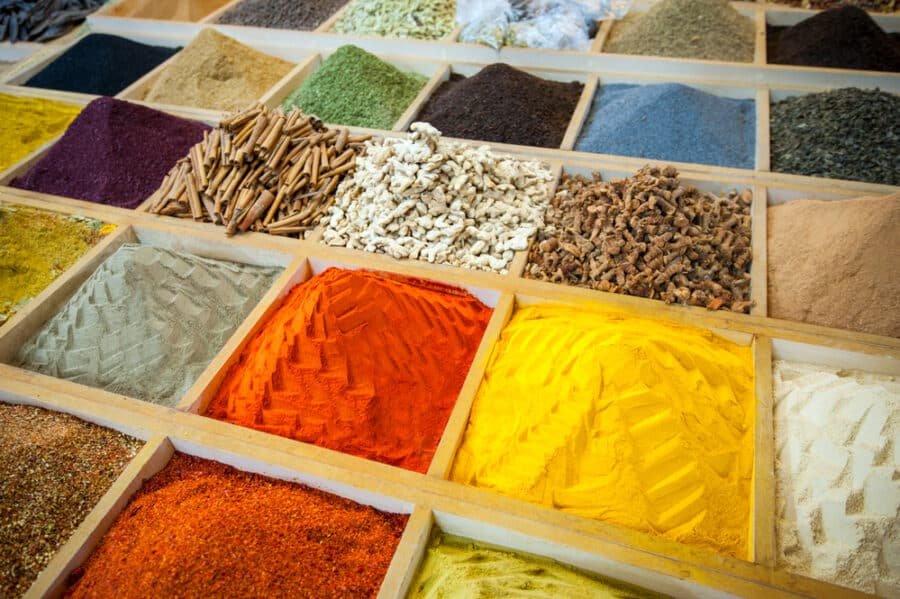
Here is a list of commonly used spices in Turkish cuisine. While I have made my list of the most commonly used spices in Turkish cuisine, the use of spices varies from region to region.
- Allspice (Yenibahar)
- Aleppo Pepper
- Baharat Spice Mix
- Black Pepper (Karabiber)
- Cardamom (Karadamom)
- Cinnamon
- Cloves (Karanfil)
- Coriander (Kişniş)
- Cumin Seeds
- Dried Dill (Dereotu)
- Dried Mint Leaves
- Dried Oregano Leaves
- Dried Thyme (Kekik)
- Fenugreek Seeds (Helbeh)
- Ginger (Zencefil)
- Isot Pepper Flakes
- Mahlab
- Marash Pepper
- Nigella Seeds (Kalonji)
- Nutmeg (Muskat)
- Paprika
- Saffron (Safran)
- Sumac
- Turmeric (Zerdeçal)
- Urfa Biber
My Favorite Turkish Dishes That Use These Spices
- Kofte: these flavorful meatballs are typically made with ground lamb or beef and seasoned with cumin, paprika, chili flakes, and other spices
- Imam bayildi: a classic vegetarian dish consisting of roasted eggplant stuffed with tomatoes, onions, garlic, and herbs
- Lahmacun: also known as Turkish pizza, this flatbread is topped with a spicy mixture of ground meat, vegetables, and herbs. It’s the perfect snack or appetizer.
- Baklava: a sweet dessert made with layers of phyllo dough filled with nuts and soaked in syrup or honey
- Rice pilaf: a flavorful rice dish made with saffron, chicken broth, butter, and various spices such as cumin and oregano
Top 25 Must-Have Turkish Spices For Your Kitchen
With these spices in your pantry, you’ll be able to make a variety of delicious Turkish dishes at home. Here are some of our favorites:
1. Sumac
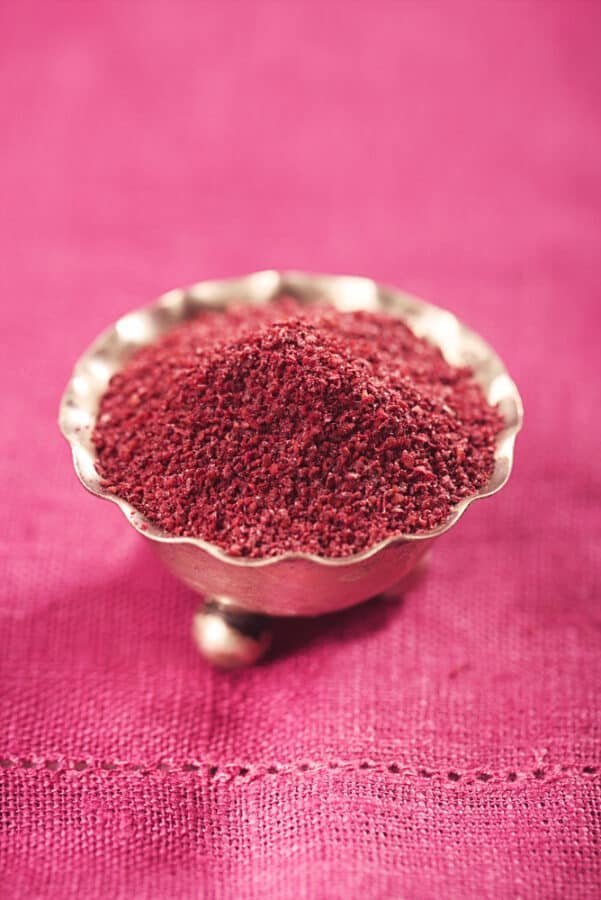
Sumac is a reddish-purple spice derived from the dried and ground berries of the sumac shrub. It is commonly used in Turkish cuisine to add a tangy and citrusy flavor to various dishes.
In Turkey, sumac is a key ingredient in dishes such as “pide” (Turkish flatbread) and “lahmacun” (Turkish pizza). It is often sprinkled on top of these breads to enhance their taste. Sumac is also used in salads, especially the traditional Turkish salad called “Shepherd’s Salad” or “Coban Salatasi,” where it adds a zesty and acidic note.
Sumac also spices up meat and doner kebabs. It is often used as a seasoning for grilled or roasted meats, especially those famous “Adana kebabs,” to provide a tangy contrast to the rich flavors of the meat.
Sumac is an essential ingredient in the popular Turkish seasoning blend called “za’atar,” which typically includes dried herbs, sesame seeds, sumac, and sometimes salt. This versatile spice blend is used in various Turkish dishes, including marinating meats, seasoning vegetables, and flavoring dips and sauces.
This versatile spice in Turkish cuisine brings a distinct tanginess and brightness to a range of dishes, including bread, salads, meats, and spice blends.
2. Ginger (Zencefil)
What is Ginger?
Ginger, known as ‘Zencefil’ in Turkish, is a flowering plant whose rhizome, ginger root, is widely used as a spice. It has a warm, slightly sweet, and peppery flavor.
Uses in Turkish Cooking
In Turkish cuisine, ginger is often used in spice mixes, particularly in those meat dishes and some sweet confections. It adds a warm, spicy kick to dishes.
Famous Turkish Dish Featuring Ginger
Ginger is commonly used in the seasoning of ‘Tavuk Şiş,’ Turkish chicken skewers. It adds a subtle warmth and spice to the marinade, enhancing the flavor of the grilled chicken.
3. Dried Dill (Dereotu)

What is Dried Dill?
Dried Dill, ‘Dereotu’ in Turkish, is an herb with a delicate, slightly sweet, and grassy flavor. It’s the dried version of the fresh dill weed.
Uses in Turkish Cooking
Dill is widely used in Turkish cuisine, especially in seafood dishes, yogurt sauces, and in combination with other herbs and spices in various vegetable dishes.
Famous Turkish Dish Featuring Dried Dill
‘Dill and Lemon Fish,’ a simple yet flavorful Turkish fish dish, often includes dried dill. The herb complements the lemony flavor and other seasonings, enhancing the fresh taste of the fish.
4. Mahlab
What is Mahlab?
Mahlab is a spice made from the seeds of the St Lucie cherry. It has a sweet, nutty, and slightly cherry-like flavor.
Uses in Turkish Cooking
Mahlab is primarily used in Turkish baking, particularly in sweet breads and pastries. It imparts a subtle almond-like flavor that’s unique and highly prized.
Famous Turkish Dish Featuring Mahlab
‘Tahinli Çörek,’ a Turkish sweet bread roll filled with tahini and sugar, often includes mahlab. This spice adds a delicate, aromatic flavor to the dough, making these pastries a favorite in Turkish bakeries.
5. Aleppo Pepper
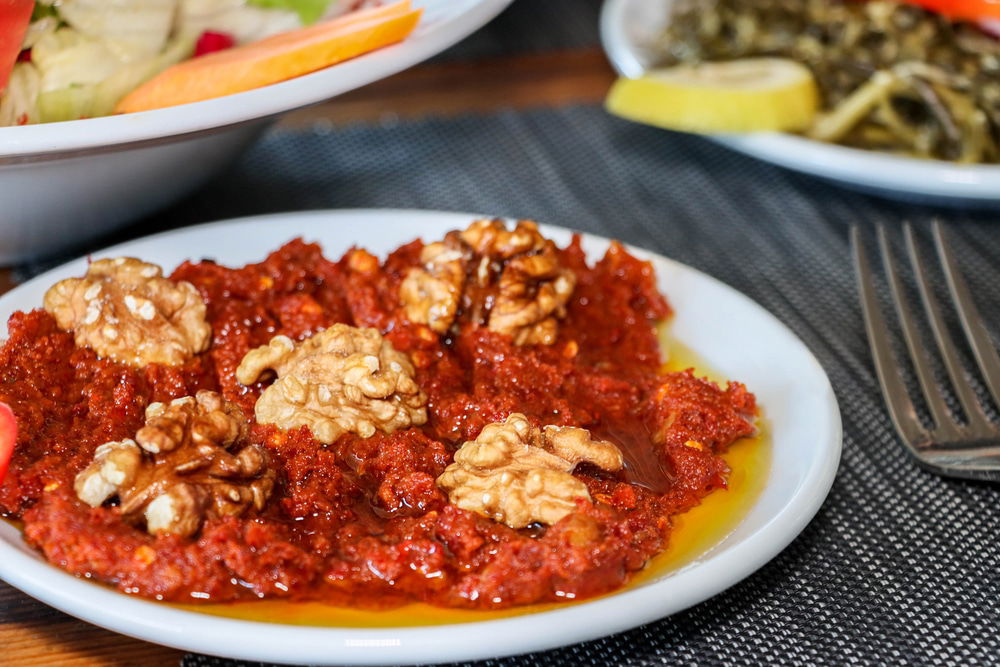
Aleppo pepper, also known as pul biber, is a chili pepper originating from the Aleppo region in Syria. It is named after the city and is widely used in Turkish cuisine for its mild to moderately spicy flavor and fruity undertones.
In Turkish cuisine, Aleppo pepper is used as a versatile spice that adds depth and a touch of heat to various dishes. Here are some common uses of Aleppo pepper in Turkish cuisine:
- Seasoning: this Turkish pepper is frequently used as a seasoning for meat, poultry, and fish. It can be sprinkled directly on grilled or roasted meats or kebabs or added to marinades and rubs to enhance the flavor.
- Flavoring Dips and Sauces: it is often added to yogurt-based dips like “cacık” or “haydari” to give them a hint of heat and a smoky flavor. Aleppo pepper can also be used in tomato-based sauces, such as “salsa” or “muhammara,” for an extra kick.
- Spice Blends: Aleppo pepper is a key component in Turkish spice blends like “za’atar” and “baharat.” These blends are used to season a variety of dishes, including meat, vegetables, and grains
- Salad Dressings: Aleppo pepper can be incorporated into salad dressings to provide a mild spiciness and a unique flavor. It pairs well with olive oil, lemon juice, and herbs, making it an excellent addition to salads.
- Finishing Touch: Aleppo pepper can be sprinkled on top of finished dishes like soups, stews, or roasted vegetables to add a pop of color, mild heat, and a smoky aroma
When using Aleppo pepper in your cooking, I recommend starting with small amounts and adjusting according to your desired level of spiciness.
6. Coriander (Kişniş)
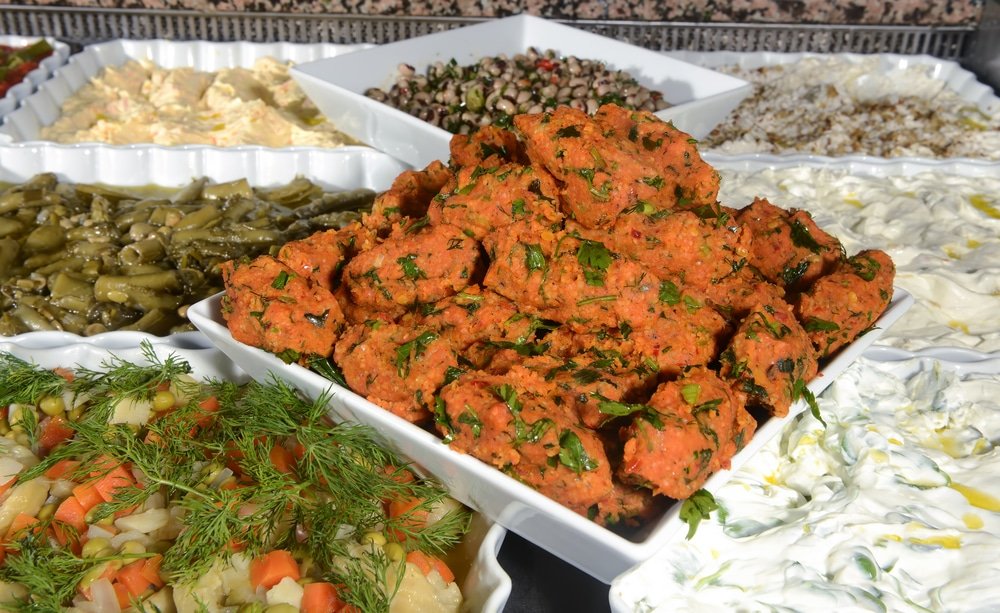
What is Coriander?
Coriander, known as ‘Kişniş’ in Turkish, is an aromatic herb that is widely used in various cuisines around the world. In its fresh form, it’s known as cilantro, but in the context of Turkish cuisine, when we say coriander, we usually refer to the dried coriander seeds of the plant. These seeds are small round, and have a warm, earthy, and slightly citrusy flavor profile.
Uses in Turkish Cooking
In Turkish cuisine, coriander is often used in its ground form, which allows its warm, nutty, and slightly spicy flavor to infuse into dishes. It’s not as prominently used as in some other Middle Eastern or Asian cuisines, but when it is used, it adds a distinctive taste. Coriander pairs well with cumin, another popular spice in Turkish cooking, and is often used in spice blends and rubs for meats.
Famous Turkish Dish Featuring Coriander
One classic Turkish dish where coriander shines is in ‘Mercimek Köftesi,’ or lentil meatballs. Although this dish is meatless, it’s referred to as ‘köfte’ due to its shape and texture. Mercimek Köftesi is a beloved vegetarian dish made from red lentils and bulgur.
Coriander, along with other spices like cumin and paprika, is used to season the lentil mixture, giving these meatballs a rich and earthy flavor. The dish is often served with fresh lemon wedges, enhancing the citrus notes of coriander and providing a refreshing contrast to the warm spices.
7. Urfa Biber
Urfa Biber, also known as Urfa pepper or Isot pepper, is a unique chili pepper variety native to the Urfa region in Turkey. It is named after the city of Urfa and is a crucial ingredient in Turkish cuisine, particularly in the southeastern region.
Urfa Biber has a dark red to purplish-black color and a smoky, earthy flavor with a moderate level of heat. The peppers are sun-dried during the day and then sweated overnight, resulting in a distinct flavor profile. The drying process imparts a rich, raisin-like sweetness and a smoky aroma to the peppers.
Turks use Urfa Biber in various ways to enhance the taste of their dishes:
- Seasoning: Urfa Biber is commonly used as a seasoning for meat and vegetable dishes. It can be added to marinades, rubs, or directly sprinkled on grilled meats, kebabs, and roasted vegetables to impart a smoky and mildly spicy flavor.
- Spice Blends: It is often included in Turkish spice blends, such as “baharat,” to add complexity and depth of flavor. These spice blends are used in meat preparations, stews, and rice dishes.
- Condiments: Urfa Biber is also utilized in condiments and sauces. It can be mixed with olive oil, garlic, and other ingredients to create a flavorful dipping sauce or drizzled over dishes like hummus, yogurt, or roasted eggplant.
- Bread and Pastries: In southeastern Turkish cuisine, Urfa Biber is occasionally incorporated into bread dough or sprinkled on top of pastries like “pide” and “lahmacun” to add a smoky and slightly spicy taste
- Salads and Mezes: Some Turkish salads and mezes (appetizers) include Urfa Biber for a subtle heat and smokiness. It can be added to salads, such as “shepherd’s salad,” or mixed with ingredients like tomatoes, cucumbers, and herbs.
Urfa Biber is known for its distinct flavor and is considered a prized ingredient in Turkish cuisine. Its complex taste profile and moderate spiciness make it a versatile addition to a wide range of dishes, adding depth, smokiness, and a hint of heat.
8. Turmeric (Zerdeçal)
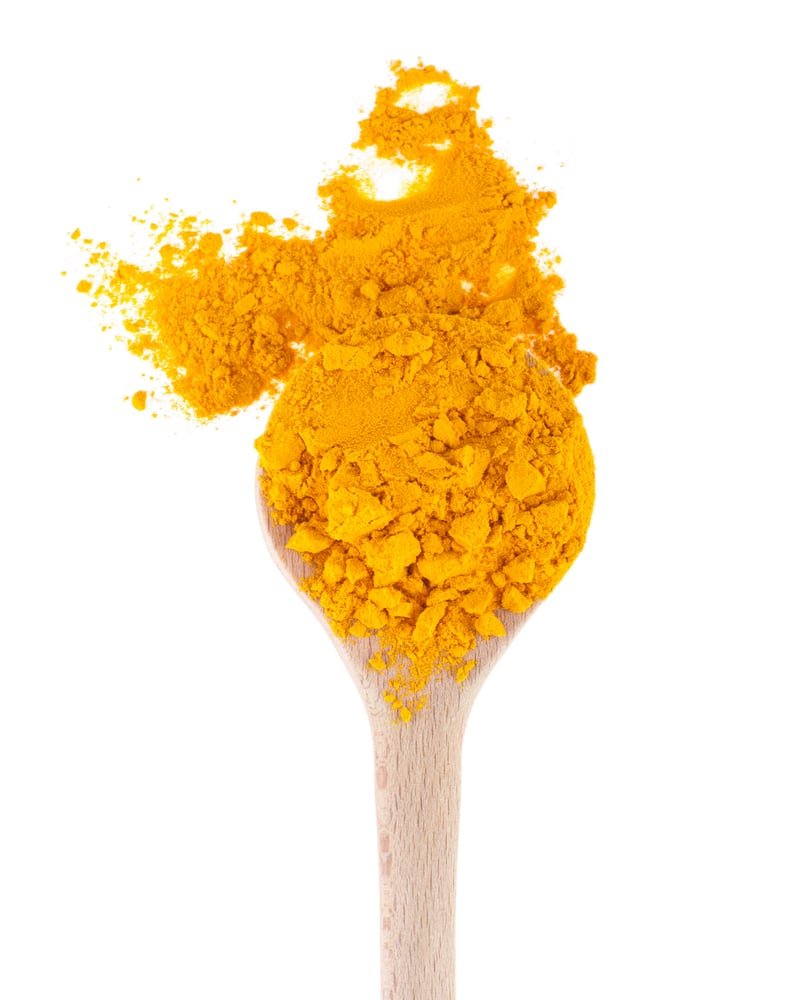
What is Turmeric?
Turmeric, referred to as ‘Zerdeçal’ in Turkish, is a bright yellow spice from the turmeric plant. It has a warm, bitter taste and is frequently used to color and flavor foods.
Uses in Turkish Cooking
While not traditionally used in ancient Turkish cuisine, turmeric has found its way into modern Turkish cooking, often used in rice dishes and soups and to add color and a mild flavor to various dishes.
Famous Turkish Dish Featuring Turmeric
‘Pilav,’ a simple yet staple Turkish rice dish, sometimes includes turmeric. It imparts a golden hue and a subtle earthiness to the rice, making it visually appealing and flavorful.
9. Saffron (Safran)
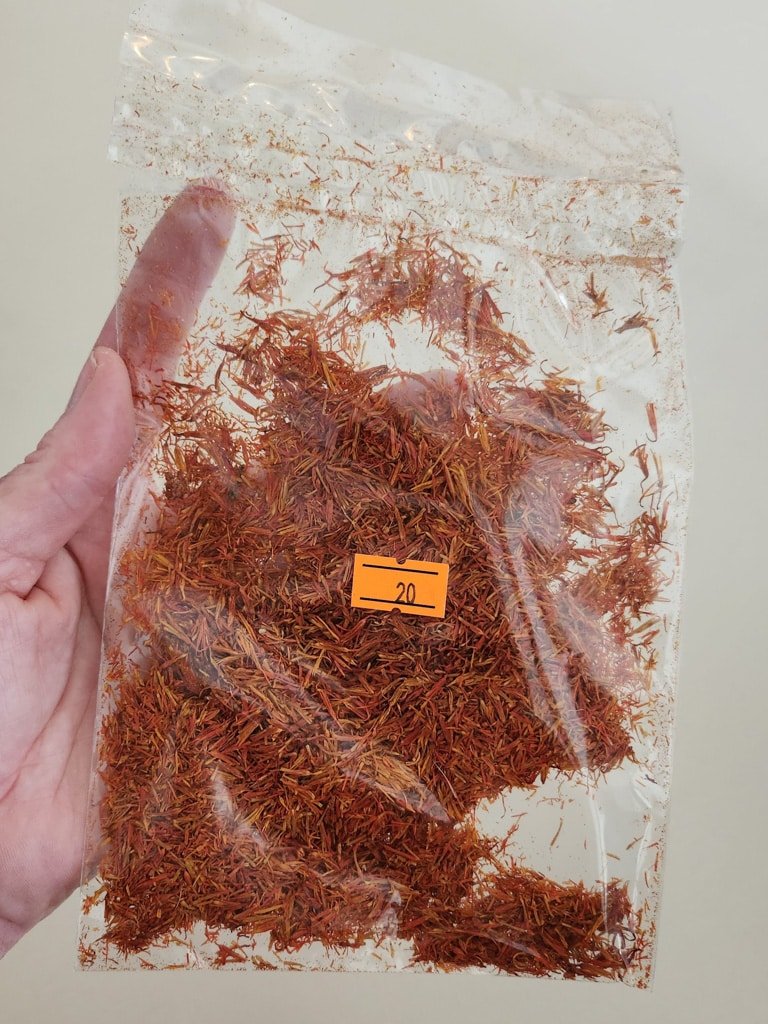
What is Saffron?
Saffron, known as ‘Safran’ in Turkish, is a highly valued spice derived from the flower of Crocus sativus. Known for its distinctive aroma and golden color, it’s one of the most expensive spices by weight.
Uses in Turkish Cooking
Saffron is used sparingly in Turkish cuisine due to its high cost. It’s typically used in rice dishes, desserts, and some seafood preparations to add color and a unique flavor.
Famous Turkish Dish Featuring Saffron
‘Safranlı Pilav,’ a saffron-flavored rice pilaf, is a luxurious Turkish dish where saffron plays a central role. It adds both a beautiful color and a delicate, floral flavor to the rice.
10. Marash Pepper
Marash pepper, also known as Maras pepper or Kahramanmaras pepper, is a type of chili pepper originating from the Marash region in Turkey. It is named after the city of Marash and is highly regarded for its distinctive flavor and moderate spiciness.
Marash pepper has a deep red color and a rich, fruity taste with a moderate level of heat. It is similar in appearance to Aleppo pepper but has a slightly different flavor profile. The peppers are sun-dried and then ground into flakes or in powder form, making them convenient for use as a spice.
In Turkish cuisine, Marash pepper is widely used to add flavor and gentle spiciness to various dishes. Marash pepper can be used in both savory and sweet dishes, so don’t be afraid to experiment with it.
Try using Marash pepper in this traditional Turkish recipe for Shepherd’s Salad:
Ingredients:
- 1 cucumber, peeled and diced
- 1 tomato, diced
- 1 green bell pepper, diced
- 1/4 cup chopped parsley
- 1/4 cup chopped mint
- 1/2 onion, diced
- 3 tablespoons olive oil
- 2 tablespoons lemon juice
- 1 teaspoon Marash pepper
- Salt and black pepper to taste
Directions:
- In a large bowl, combine the cucumber, tomato, bell pepper, parsley, mint, and onion
- Whisk together the olive oil, lemon juice, Marash pepper, salt, and black pepper in a small bowl. Pour over the vegetables and toss to coat
- Serve at room temperature or chilled
11. Baharat Spice Mix
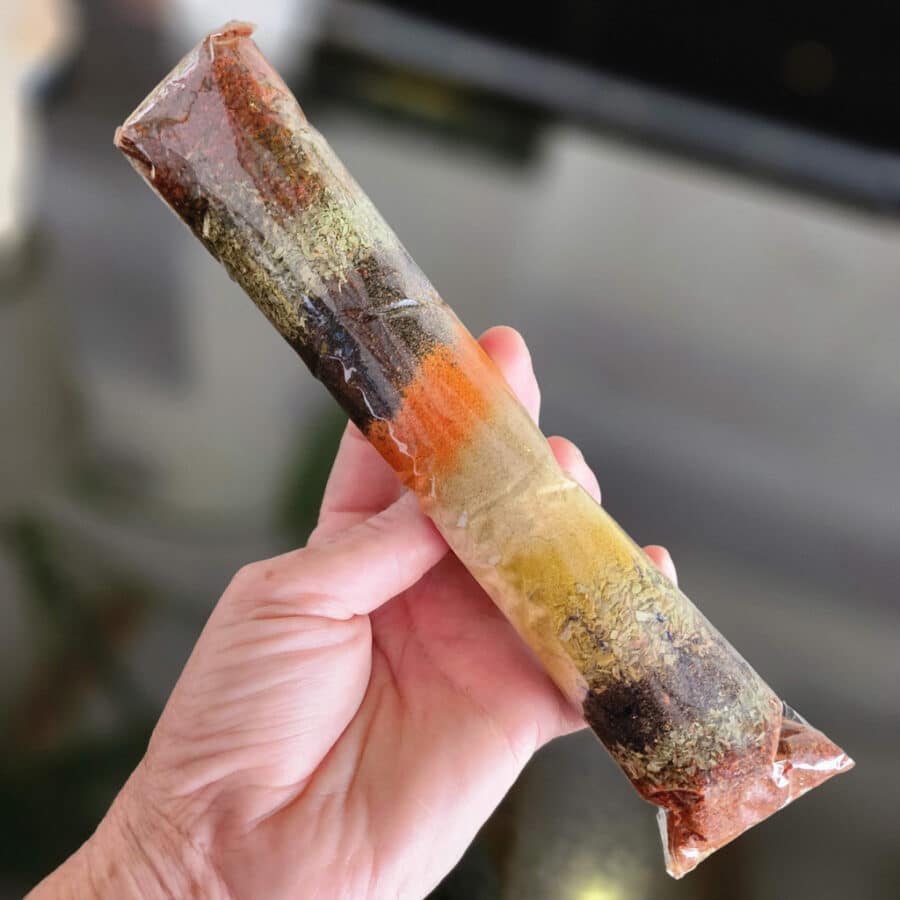
Baharat is a popular spice blend used in Turkish and Middle Eastern cuisines. It is a flavorful mix of aromatic spices such as cinnamon, cloves, cumin, coriander, nutmeg, and black pepper, among others.
The exact composition of Baharat may vary slightly depending on the region or personal preference. This versatile spice blend adds warmth, depth, and a balanced complexity to a wide range of dishes, including meat, poultry, stews, rice, and vegetable preparations.
It is often used as a dry rub or incorporated into marinades, sauces, and soups, lending a distinctive and aromatic flavor profile to the cuisine.
I brang it home as shown in the bags. The one pictured I purchased in Izmir, but the ones I got in Istanbul looked much the time. My kids loved this on chicken – so tasty.
12. Cloves (Karanfil)
What are Cloves?
Cloves, in Turkish ‘Karabiber’, are the aromatic flower buds of a tree in the family Myrtaceae. They are small, hard, and nail-shaped, known for their intense fragrance and spicy, slightly sweet flavor.
Uses in Turkish Cooking
Cloves are used sparingly in Turkish cuisine due to their intense flavor. They are commonly added to meat dishes, soups, and stews, often in combination with other spices like cinnamon and Turkish bay leaves. Cloves are also used in the preparation of traditional Turkish beverages, such as salep and certain types of Turkish coffee, where they add a warm, aromatic depth.
Famous Turkish Dish Featuring Cloves
A notable Turkish dish using cloves is ‘Kıymalı Biber Dolması,’ stuffed bell peppers with a spicy meat filling. The cloves add a subtle yet distinct flavor to the beef or lamb mixture, complemented by rice, herbs, and other exotic spices.
13. Dried Oregano Leaves

Dried oregano leaves are a must-have for any kitchen. When I go to Greece and Turkey, I buy like a kilo every time!
This spice is commonly used in Mediterranean and Middle Eastern cuisine. Turkish oregano has a strong, pungent flavor that goes well with lamb shanks, chicken, and fish dishes. It can also be used to make a flavorful herb tea.
14. Black Pepper (Karabiber)
What is Black Pepper?
Black pepper, also referred to as ‘Karabiber’ in Turkish, is one of the most commonly used spices worldwide. It comes from the dried berries of the pepper plant and is known for its sharp, mildly spicy flavor.
Uses in Turkish Cooking
In Turkish cuisine, black pepper is used ubiquitously as a seasoning in almost every savory dish. It adds a subtle heat and enhances the overall flavor profile of meats, vegetables, soups, and stews.
Famous Turkish Dish Featuring Black Pepper
‘İskender Kebap,’ a famous Turkish dish, often features black pepper prominently. This dish includes thinly sliced grilled lamb, served over pita bread with tomato sauce, melted sheep’s butter, and yogurt. Black pepper is used to season the meat, playing a crucial role in defining its flavor.
15. Dried Mint Leaves
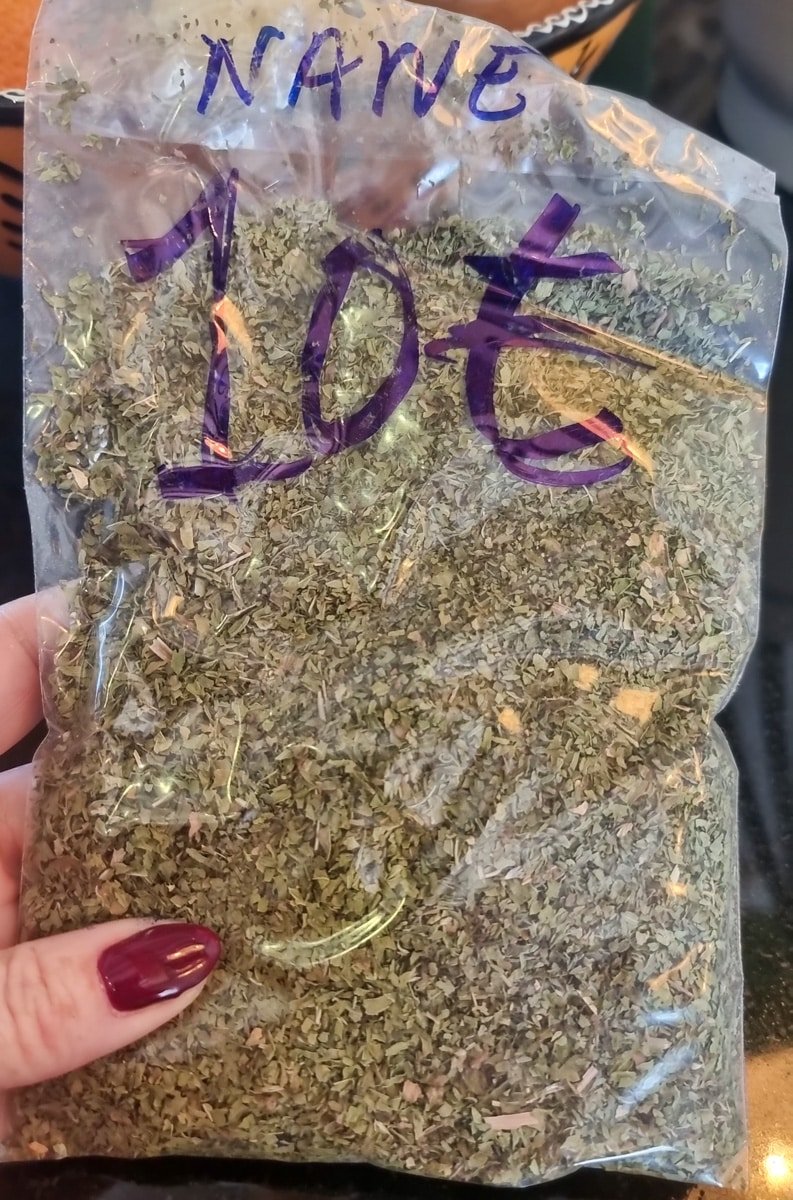
Dried mint leaves are a key ingredient in many traditional Turkish dishes. They have a strong, fresh flavor that pairs well with other spices like cumin and paprika. Mint is also a common flavor in Turkish desserts and pastries. I got this bag in February in Izmir at the spice market, and it smells divine!
16. Isot Pepper Flakes

Isot pepper flakes, also known as Urfa Biber flakes, are a type of crushed chili pepper derived from the dark purple-red Isot pepper, which is native to the Urfa region in Turkey. Isot pepper is harvested and sun-dried, then the peppers are crushed into coarse flakes, resulting in Isot red pepper flakes.
Isot pepper flakes have a unique flavor profile characterized by a smoky, fruity, and slightly sweet taste with a mild to moderate level of heat. They are known for their deep, dark color and rich aroma. The drying process contributes to their distinct flavor, as the peppers are partially fermented during the sweating and drying process.
Isot pepper flakes are commonly used as a seasoning and condiment in Turkish cuisine. They are sprinkled over various dishes, including kebabs, grilled meats, roasted vegetables, and salads, to add a smoky and mildly spicy flavor. Isot pepper flakes can also be used to enhance the taste of soups, stews, sauces, and dips, providing a unique depth of flavor. Their versatility and rich taste make Isot pepper flakes a popular ingredient in Turkish culinary traditions.
17. Cumin Seeds
Cumin seeds are one of the most essential spices in Turkish cuisine. They have a strong, earthy flavor and are used in many different dishes, from stews and soups to meat and vegetable dishes. Cumin seeds can be bought whole or ground and should be stored in a cool, dry place.
18. Nutmeg (Muskat)
What is Nutmeg?
Nutmeg, known as ‘Muskat’ in Turkish, is the seed of the nutmeg tree and is encased in a mace. It has a warm, nutty, and slightly sweet taste.
Uses in Turkish Cooking
Nutmeg is often used in small quantities in Turkish desserts, in béchamel sauce for dishes like ‘Moussaka,’ and in some meat preparations to add a sweet and spicy note.
Famous Turkish Dish Featuring Nutmeg
A classic Turkish dish using nutmeg is ‘Sütlaç,’ a traditional Turkish rice pudding. The nutmeg adds a delicate, warm flavor to this creamy, comforting dessert.
19. Paprika
Paprika is a bright red powder made from dried and ground sweet peppers. It has a mild, slightly sweet taste, and it’s commonly used to add an earthy flavor and vibrant color to dishes. Paprika is often used in Turkish cuisine, especially in dishes like kebabs, pilafs, and stews. It can also be used as a garnish for rice or potatoes.
20. Nigella Seeds (Kalonji)

Nigella seeds, also known as kalonji, are small black seeds derived from the Nigella sativa plant. They have a unique flavor, often described as earthy, nutty, and slightly peppery. Nigella seeds are commonly used as a spice in various cuisines, including Turkish cuisine.
In Turkish cuisine, nigella seeds are known as “çörek otu” and are a popular ingredient in a traditional Turkish pastry called “simit.” Simit is a circular-shaped bread covered in sesame seeds and dotted with nigella seeds, giving it a distinct appearance and flavor. Nigella seeds add a nutty and aromatic touch to simit, enhancing its overall taste.
Apart from simit, nigella seeds are also used as a garnish in other Turkish bread, such as “pide” (Turkish flatbread) and “çörek” (Turkish pastry). Additionally, they can be sprinkled on top of salads and savory pastries or mixed into spice blends to provide a subtle and distinctive flavor.
While simit is the most well-known Turkish dish that prominently features nigella seeds, they can be found in a variety of other recipes, adding a delightful twist to the flavors of Turkish cuisine.
21. Dried Thyme (Kekik)
What is Dried Thyme?
Dried Thyme, or ‘Kekik’ in Turkish, is a Mediterranean herb known for its strong, earthy, and slightly minty flavor.
Uses in Turkish Cooking
Thyme is a key ingredient in many Turkish meat dishes, soups, and vegetable preparations. It is also a component of the classic ‘Za’atar’ spice mix, often used to season flatbreads and meats.
Famous Turkish Dish Featuring Dried Thyme
‘Menemen,’ a traditional Turkish egg scramble with tomatoes, green peppers, and onions, often includes dried thyme. The herb adds a distinct aroma and depth to this popular breakfast dish.
22. Fenugreek Seeds (Helbeh)
Fenugreek seeds, also known as helbeh in Turkish, are small, golden-brown seeds derived from the fenugreek plant. They have a strong, aromatic flavor with a hint of bitterness and a slightly nutty taste. Fenugreek seeds are widely used in Turkish cuisine as a spice and a herbal remedy.
In Turkish cuisine, fenugreek seeds are utilized in various ways:
- Spice and Seasoning: fenugreek seeds are often dry-roasted to enhance their flavor before being ground into a powder or used whole. They are used as a spice in meat dishes, stews, curries, and vegetable preparations. Fenugreek seeds contribute a unique depth of flavor and distinctiveness to the overall taste of the dishes.
- Herbal Remedy: fenugreek seeds are also valued for their potential health benefits and are used in traditional herbal remedies. They are believed to aid digestion, reduce inflammation, and regulate blood sugar levels. Fenugreek seeds can be steeped in hot water to make a herbal tea or ground into a paste for external use.
- Spice Blends: fenugreek seeds are a key ingredient in Turkish spice blends, such as “baharat” and “çemen,” which are used to season a variety of dishes, including grilled meats, kebabs, and vegetables.
- Bread and Pastries: fenugreek seeds are sometimes used as a topping or incorporated into the dough for bread and pastries. They can be sprinkled on top of bread or added to the dough for a slightly bitter and aromatic touch.
Fenugreek seeds are known for their strong flavor and are used to add a distinctive taste to Turkish dishes. While they are primarily used as a spice, their potential health benefits and versatile applications make them an integral part of Turkish culinary traditions.
23. Allspice (Yenibahar)
What is Allspice?
Allspice, known as ‘Yenibahar’ in Turkish, is a spice made from the dried berries of the Pimenta dioica plant. It combines flavors of cloves, nutmeg, and cinnamon.
Uses in Turkish Cooking
Allspice is used in a variety of Turkish dishes, including meat dishes, stews, and even some desserts. It is also a common ingredient in spice mixes and marinades, lending a warm, complex flavor.
Famous Turkish Dish Featuring Allspice
In Turkish ‘Köfte’ (meatballs), allspice is a key ingredient. It adds a warm, nuanced flavor to the ground meat mixture, which is typically grilled or fried.
24. Cardamom (Karadamom)
What is Cardamom?
Cardamom, or ‘Karadamom’ in Turkish, is a spice made from the seeds of several plants in the ginger family. It has a strong, unique taste with an intensely aromatic, resinous fragrance.
Uses in Turkish Cooking
Cardamom is used in Turkish coffee and in some dessert recipes. It’s not as commonly used in savory dishes but is occasionally added to certain rice dishes and stews for an aromatic touch.
Famous Turkish Dish Featuring Cardamom
Turkish coffee is renowned for its use of cardamom. The spice is either blended with coffee grounds or added whole to the coffee pot, imparting its distinctive flavor to this iconic Turkish beverage.
25. Cinnamon
Cinnamon is a highly aromatic spice obtained from the inner bark of trees belonging to the Cinnamomum family. It is commonly used in cooking and baking for its distinct sweet and warm flavor and pleasing aroma.
Cinnamon is available in two main varieties: Ceylon cinnamon (also known as “true” cinnamon) and Cassia cinnamon. Ceylon cinnamon is lighter in color and has a subtle and delicate flavor, while Cassia cinnamon has a stronger and more intense taste. Both varieties are widely used in different culinary traditions.
Brands We Use And Trust
Move This Adventure To Your Inbox & Get An Instant Freebie

No spam. Unsubscribe at any time.
Tips On Buying Spices From Turkey At The Bazaars

When it comes to buying spices, the Turkish bazaars are a great place to shop. However, there are a few things to keep in mind when shopping for spices at the bazaars to ensure that you’re getting the best quality possible.
- Take a look at the overall condition of the spice. It should be dry and free from any mold or mildew. If it looks wet or has any visible moisture on it, it’s likely not fresh and won’t have as much flavor.
- Smell the spice. It should be fragrant and have a strong aroma. If it doesn’t smell very potent, it’s likely not fresh and won’t pack as much of a flavor punch.
- See who is buying it. If the locals are buying it, you know it’s good!
How To Properly Store Your Turkish Spices
When it comes to storing your spices, there are a few things you need to keep in mind. First, you want to ensure they are stored in a cool, dry place. This will help to keep them fresh and prevent them from going bad.
Secondly, you want to ensure they are stored in an airtight container. This will help to keep their flavor and aroma locked in.
Lastly, you want to make sure that they are stored away from direct sunlight. This will help to prevent them from fading or becoming discolored.
| Storage Tip | Details |
|---|---|
| Cool, Dry Places | Store in a pantry or cupboard away from heat and moisture. |
| Airtight Containers | Use spice jars with tight lids or zip-lock bags to retain freshness. |
| Avoid Sunlight | Store away from direct sunlight to prevent fading and loss of flavor. |
| Labeling | Label your spices with names and dates for easy identification and freshness tracking. |
| Buy in Moderation | Purchase smaller quantities to ensure freshness. |
| Regular Checks | Periodically check for aroma and clumping; replace if necessary. |
Most Popular Spice Markets In Turkey
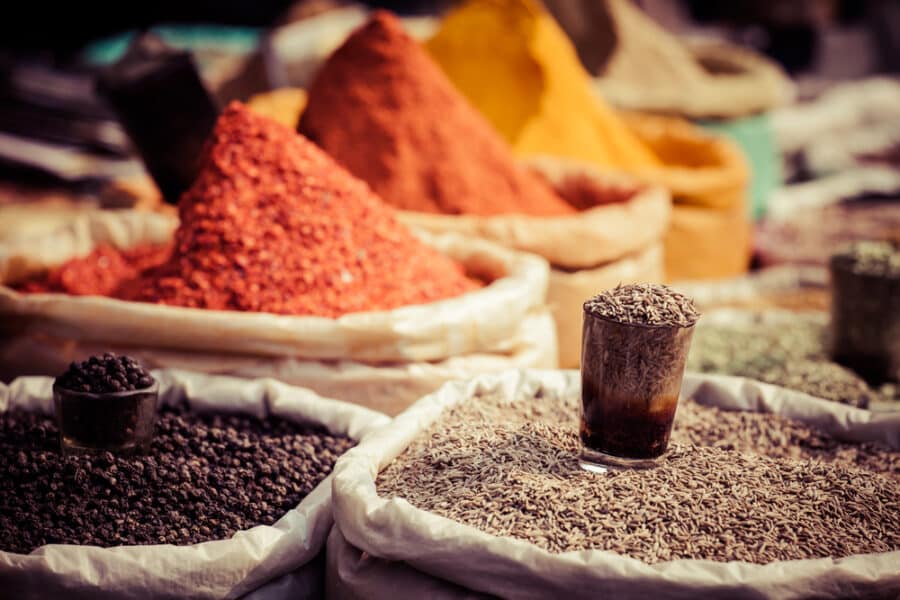
Turkey is famous for its vibrant spice markets, known as “bazaars” or “çarşı” in Turkish. These markets offer a wide variety of spices, herbs, and other culinary ingredients. Here are some of the most popular spice markets in Turkey:
Spice Bazaar (Mısır Çarşısı) – Istanbul
Located in the Eminönü district of Istanbul, the Spice Bazaar is one of the largest and oldest covered spice markets in the city. It offers a vast selection of spices, dried fruits, nuts, teas, and Turkish delights
Grand Bazaar (Kapalıçarşı) – Istanbul
while not solely dedicated to spices, the Grand Bazaar in Istanbul is a massive covered market with numerous shops selling spices alongside other goods. It is a bustling and historic market that attracts visitors from around the world.
Egyptian Bazaar (Mısır Çarşısı) – Manisa
Situated in the city of Manisa, the Egyptian Bazaar is renowned for its diverse array of spices and herbs. It is a vibrant market where visitors can find local spices and unique regional flavors.
Arasta Bazaar – Antalya
Located in the historic district of Kaleiçi in Antalya, the Arasta Bazaar is a charming market offering a range of spices, including local specialties. It is a great place to explore and discover the flavors of the Mediterranean region.
Spice Market – Gaziantep
Gaziantep, a city in southeastern Turkey, is known for its rich culinary traditions. The Spice Market in Gaziantep is a popular destination for spice enthusiasts, offering an extensive selection of aromatic spices and specialty ingredients used in regional dishes.
Alaca Han Market – Ankara
Alaca Han Market in Ankara is a bustling market where visitors can find a variety of spices, including regional specialties. It is a vibrant place to explore and experience the local culinary culture.
Uzun Çarşı – Bursa
Uzun Çarşı, meaning “Long Market,” is a historic market in the city of Bursa. It features numerous shops selling spices, nuts, Turkish delights, and traditional food products, making it a delightful place to explore Turkish flavors.
These are just a few examples of the popular spice markets in Turkey. Each market offers a unique atmosphere and a wide range of aromatic spices, allowing visitors to immerse themselves in the vibrant culinary culture of the country.
FAQs
What is the red spice in Turkish food?
The red spice commonly used in Turkish food is called “pul biber,” a type of dried chili pepper with a slightly sweet and smoky flavor and varying levels of heat, used in a wide range of Turkish dishes as a garnish.
What is an excellent Turkish spice mix for chicken?
A popular spice mix for chicken in Turkey is “baharat,” including warm spices such as cinnamon, allspice, nutmeg, and cardamom, providing a flavorful blend when rubbed onto the meat before cooking or added to marinades or sauces.
What is Turkish all-purpose seasoning?
Turkish all-purpose seasoning is a blend of spices commonly used in Turkish cuisine to add flavor and depth to dishes, including paprika, cumin, coriander, garlic, onion, and black pepper.
What are the most common spices used in Turkish cooking?
Common spices in Turkish cooking include cumin, paprika, sumac, mint, coriander, oregano, and black pepper, contributing to the diverse and rich taste profile of Turkish cuisine, offering both versatility and distinct flavor to a range of dishes.
So, tell me, which of these most popular spices from Turkey will you try first?


What is the green powdered spice used. It’s not leaves.
A green powdered spice commonly used in Turkish cuisine is likely to be dried mint. Mint, when dried and ground, becomes a fine green powder and is frequently used in a variety of Turkish dishes for its fresh, aromatic flavor. Another possibility could be dried and ground parsley, which is also used in Turkish cooking, although it’s less commonly found in powdered form compared to mint.